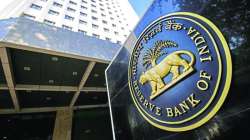RBI's reverse repo cut significant, but banks need to increase risk appetite: Economists
The reduction in reverse repo rate by 25 basis points to 3.75 per cent by the Reserve Bank is a significant step but it is important that banks should increase their risk appetite, say economists and analysts.

The reduction in reverse repo rate by 25 basis points to 3.75 per cent by the Reserve Bank is a significant step but it is important that banks should increase their risk appetite, say economists and analysts. The Reserve Bank of India on Friday announced a 25 basis points reduction in reverse repo to 3.75 per cent from 4 per cent in order to encourage banks to deploy these surplus funds in investments and loans in productive sectors of the economy.
"The reduction of reverse repo is significant but it needs to be seen if the flow to the private sector actually increases," Care Ratings Chief Economist Madan Sabnavis said.
DBS Bank India Economist Radhika Rao said the reduction in the reverse repo rate is meant to prod banks to consider lending activity rather than park funds with the central bank.
"Given the still sizeable funds that is being parked with the central bank under the reverse repo operations even after the 90 basis points cut in March, points to the limited credit and risk appetite of financial institutions," Rao said, while cautioning that a further reduction might disincentives banks to utilise the reverse repo window.
SBI's Group Chief Economic Advisor Soumya Kanti Ghosh said the RBI has excluded the accounts availing moratorium from the 90-day NPA norm, thus providing a breather to banks as well as customers.
"However, given the working capital challenges it is advisable for the RBI now to relook at the 90-day norm," he said.
Ghosh said once an account is classified NPA, the borrower will not be able to raise funds from any other lender.
"In the current circumstances the only way to save the economy and the financial system seems to be a relaxation of the IRAC norms i.e extending the 90-day schedule to 180 days," he said.
Ghosh, however, said this relaxation should be given along with a well laid out calendar of returning to the current norm of 90 days in the next two years, by which time hopefully the Covid-19 crisis would have subsided.
RBI also announced targeted long-term repo operations (TLTRO 2.0) for an aggregate amount of Rs 50,000 crore, to begin with, in tranches of appropriate sizes.
The funds availed under this will have to be invested in investment grade bonds, commercial paper, and non-convertible debentures of NBFCs, with at least 50 per cent of the total amount availed going to small and midsized NBFCs and MFIs.
KPMG India Partner and Head (CFO Advisory) Sai Venkateshwaran said "the TLTRO 2.0 for a total of Rs 50,000 crores, will provide some of the much needed liquidity for NBFCs, that have been faced with a significant ALM mismatch as they haven't benefited from the grant of moratorium announced by RBI earlier."
RBI also announced providing special refinance facilities for a total amount of Rs 50,000 crore to Nabard, Sidbi and NHB to enable them to meet sectoral credit needs.
Crisil Ratings Senior Director Krishnan Sitaraman said the twin funding measures announced by RBI will definitely provide some relief to NBFCs / HFCs / MFIs who have been providing moratorium on their loans to borrowers but were facing uncertainty in obtaining moratorium on their bank loans.
"At the same time the fact that no formal announcement was made on applicability of bank loan moratorium to NBFCs would be a dampener for them," he said.
According to EY India's Economist and Chief Policy Advisor D K Srivastava, the two measures -- reduction in reverse repo and increase in the state governments' WMA limits by 60 per cent of the original limit -- would facilitate increase in economic activities as the lockdown is progressively eased.
RBI further said in respect of all accounts for which lending institutions decide to grant moratorium or deferment, and which were standard as on March 1, 2020, the 90-day NPA norm shall exclude the moratorium period, that is there would be an asset classification standstill for all such accounts from March 1, 2020 to May 31, 2020.
"With the objective of ensuring that banks maintain sufficient buffers and remain adequately provisioned to meet future challenges, they will have to maintain higher provision of 10 per cent on all such accounts under the standstill, spread over two quarters, i.e., March, 2020 and June, 2020," RBI said.
According to Icra Ratings Senior Vice President and Group Head (financial sector) Karthik Srinivasan, the proposal for 10 per cent provisions on the accounts under the standstill on asset classification because of moratorium is likely to significantly increase the credit provisions for the banks.
"With an estimate of 3-4 per cent of the bank credit being in overdue category, i.e. SMA 1 and SMA2, which currently requires provision of only 0.4 per cent, the provisioning requirements of banks can increase by Rs 300-400 billion because of the proposed regulations," he said.
Deloitte India's Economist Rumki Majumdar said the ability to grant relaxed NPA classification to borrowers and excluding NPA classification from the moratorium period will encourage NBFCs to lend to MSMEs without worrying about the impact such lending may have on their NPAs, which have been high.
According to Covestro India's Head of Finance Avinash Bagdi, the bold steps taken by RBI to ensure smooth functioning of banks and financial institutions will help the country to prevent the economic slowdown curve from steepening.